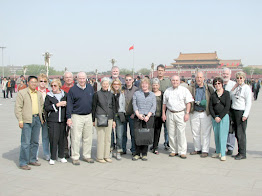In case you hadn’t noticed in day one, our schedule was filled from early morning until night. I was thankful for the bus rides because it gave me a chance to rest a bit, and it was also very good for John because his ability to walk long distances for long periods was not very good.
Our second day’s itinerary
included a trip to the Great Wall, lunch at The Friendship Store Restaurant,
followed by a visit to the Ming Tombs and dinner at the Peking Duck Restaurant
with the Vice President of Beijing People’s Association for Friendship with
Foreign Countries. We returned to our hotel at 8:30 pm. And, I had the time
wrong for the first day…we got back to the hotel at 9:00 pm.
The Great Wall of China is amazing. I don’t know how long it would take to walk along the entire distance, but just walking up the steps at Badaling was a lot of exercise. Then, once you’re on top of the wall, you can walk in either direction and reach the watchtowers in which sentries could live and store weapons. The wall is built of large rectangular granite stones and bricks. It is over 25 feet high in most places and wide enough that five horses could gallop abreast or ten people could march shoulder to shoulder.
After the Great Wall, we stopped at a cloisonné factory and were provided with a tour that illustrated how this beautiful artwork is made. It’s quite the process and takes some time. We were shown metal objects prior to having metal compartments (cloisons in French) added to the base object. Then, depending on the design, enamel powder paste or other materials are used to fill in the various compartments to make a design. Once it’s finished, it has to be fired in a kiln and then polished. Originally cloisonné was used mainly for jewelry or small objects. When this enamel technique came to China in the 14th century the Chinese adapted it to larger items like bowls and vases. At that time, it was only used by the royal families as a symbol of authority and status. The photos show a work in progress and a finished work. Very interesting.
Most meals in China, if
not all, were at round tables with a large Lazy Susan (don’t know what the
Chinese call these) in the middle of the table. Dishes were brought out and
placed on the turntable, and as it went around, you helped yourself from
whichever dish caught your fancy. What was amazing was the number of dishes
that were brought to each meal (with the exception of breakfast which was a
buffet), and none of them ever included rice. In China, rice is a poor person’s
meal. In all the time we were there, rice was served only once and then because
it was requested by someone.
Something else we learned
is the importance of your party is indicated by the number of dishes served.
Now I cannot read Chinese, but understood the newspaper indicated the Chinese
head of state, visiting the United States while we were in China, was provided
dinner by Bill Gates. Even though only the best of everything available was
served, it amounted to very few courses…not honorable.
I’d also like to say that I tried everything offered and it was nothing like what we call Chinese food in America. It was delicious and only once did I very carefully spit something into my napkin. I have no idea what it was, but it looked like clear gummy bears and tasted like a very nasty rotten fish.
Bellies full, we clambered back on the bus and headed for the Ming Tombs. This is an amazing place. There is a promenade with large carved people and animals on each side. These included elephants, horses, turtles, camels, noblemen, all absolutely beautiful. A very nice walk on a very nice spring day.
It has been many years, so my memory may not be exact, but I believe it was at the Peking Duck restaurant that we were served Peking duck. The entire duck is cooked, and you may partake of any portion of it you like. Everyone but John was grossed out by the head and John ate several. He said they were very tasty.
The following morning our luggage had to be out the door by 7:30 am. Following breakfast, we headed for
Tian’anmen (that’s how it appears in Chinese printing) Square. This is where
the People’s Republic of China was proclaimed in 1949. IT is also the largest
city square in the world. We did not get a chance to see Chairman Mao’s tomb or
Chairman Mao lying in state therein because the line was hours long. It is
always hours long. There was no discussion about what had happened in that
square all those years ago.
Here I’ve included a photo
of the entire group that went on this tour. I also scanned a postcard I bought
because I wanted to talk about the flowers. China must have the largest
greenhouses in the world. When you see plantings like this, they are not placed
in the earth. Pots containing the flowers are placed adjacent each other to
create what you see on this postcard. I have no idea how often they have to
water or replace the various plants, but it has to be way more work than planting
in dirt and watering.
For lunch, we had fast food
at the airport and departed for Kunming. Below I’ve placed some additional
photos just FYI.













